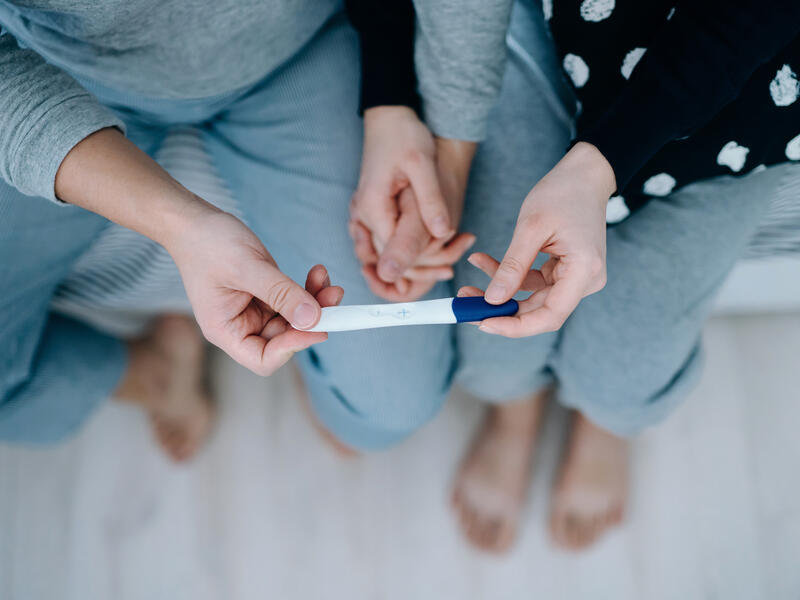In most pregnancies, the fertilized egg travels through the fallopian tube and implants itself in the uterus. An ectopic pregnancy, or tubal pregnancy, occurs when the embryo implants and grows outside of the uterine cavity. This occurs in up to 2% of all pregnancies.
Most ectopic pregnancies implant in the fallopian tube although some can occur within the abdomen, cervix, cesarean section scar, or ovary. As the pregnancy in the tube grows, it can put pressure on the tube or surrounding tissue and cause it to rupture and bleed. This can result in severe bleeding inside the abdomen which may be life threatening if not treated immediately.
Risk factors
One half of all women with an ectopic pregnancy have no known risk factors. Women are at increased risk of an ectopic pregnancy when there is scar tissue in the fallopian tubes resulting from a previous infection or abdominal surgery. Risk factors include a history of the following:
- Previous ectopic pregnancy
- Infection of the uterus or fallopian tubes
- Infertility
- Endometriosis
- Previous surgery of the ovaries or uterus
- Tubal sterilization (having your tubes tied)
- Sexually transmitted infections (chlamydia, gonorrhea)
- Cigarette smoking
- Age over 35
- Becoming pregnant with an intrauterine device (IUD) in place
Symptoms
The most common symptom of an ectopic pregnancy is severe pelvic or abdominal pain from internal bleeding. The bleeding originates from rupture of the fallopian tube where the embryo is growing. This blood then pools in the abdomen, causing the pain.
Symptoms of an ectopic pregnancy include:
- Lower abdominal pain
- Sharp abdominal cramps
- Light vaginal bleeding
- Nausea and vomiting with pain
- Pain on one side of your pelvis
- Weakness or dizziness
- Pain in your shoulder
Diagnosis
If you have a positive home pregnancy test with any of the above symptoms and have not had an ultrasound to confirm the pregnancy is within the uterus, you should see your doctor for further testing. An ectopic pregnancy is diagnosed by the following procedures:
- Vital signs — blood pressure and heart rate
- Pelvic exam — to determine location of the pain
- Ultrasound exam — to determine location of pregnancy and if there is bleeding
- Pregnancy hormone levels (HCG) — blood test to determine the amount of pregnancy hormone and if it is rising appropriately
HCG is a hormone normally produced during pregnancy. If an ultrasound shows there is no gestational sac or embryo inside the uterus, then the amount of pregnancy hormone (HCG) is used to confirm an ectopic pregnancy or to indicate the pregnancy might be too early to see in the uterus.
A pregnancy in the uterus may not be seen until five to six weeks’ gestation. Sometimes the ultrasound and hormone level test are repeated after 48 hours. If your pregnancy test is positive and the first ultrasound shows no gestational sac in the uterus, a repeat ultrasound should be done to make sure you do not have an ectopic pregnancy.
Treatment
The treatment for an ectopic pregnancy is either medication to stop the growth of the abnormal pregnancy or surgery to remove the pregnancy from the abnormal location. Your doctor will discuss which treatment is better considering your circumstances. This is determined by how far along you are in the pregnancy, your medical history, the findings on the ultrasound, and if there is blood in your abdomen.
Medication
A medication called Methotrexate can be used to stop the growth of the pregnancy in the tube. This is a good option for patients when the ectopic pregnancy is small, has not yet ruptured, and has not caused internal bleeding. Certain lab tests will be done to make sure it is safe to use this medication.
If medication is used for treatment, follow-up laboratory testing is needed after treatment has been completed to ensure disappearance of the pregnancy tissue. Medication treatment is effective in 70-95% of cases.
Surgery
Surgery is required to remove the ectopic pregnancy if the pregnancy is further along or there are any signs of ectopic pregnancy rupture. This is usually completed through laparoscopy, which involves placing a scope through a small incision in your abdomen.
If there is a large amount of blood in your abdomen or the pregnancy is too far along, then a larger incision may be needed in your abdomen to remove the ectopic pregnancy and blood clot.
Future pregnancies
After treatment for an ectopic pregnancy, it is possible to become pregnant again and have a healthy baby. Because an ectopic pregnancy causes damage or scarring to the fallopian tubes, there is an increased risk of having another ectopic pregnancy.
If you become pregnant after a previous ectopic pregnancy, you should see your doctor soon after you know you are pregnant so that an ultrasound exam may be completed.
Learn more
- Is spotting during pregnancy normal?
- 8 warning signs during pregnancy
- Deciding on the best birth control option after pregnancy
…
Posted In Health Information, Pregnancy, Women's
